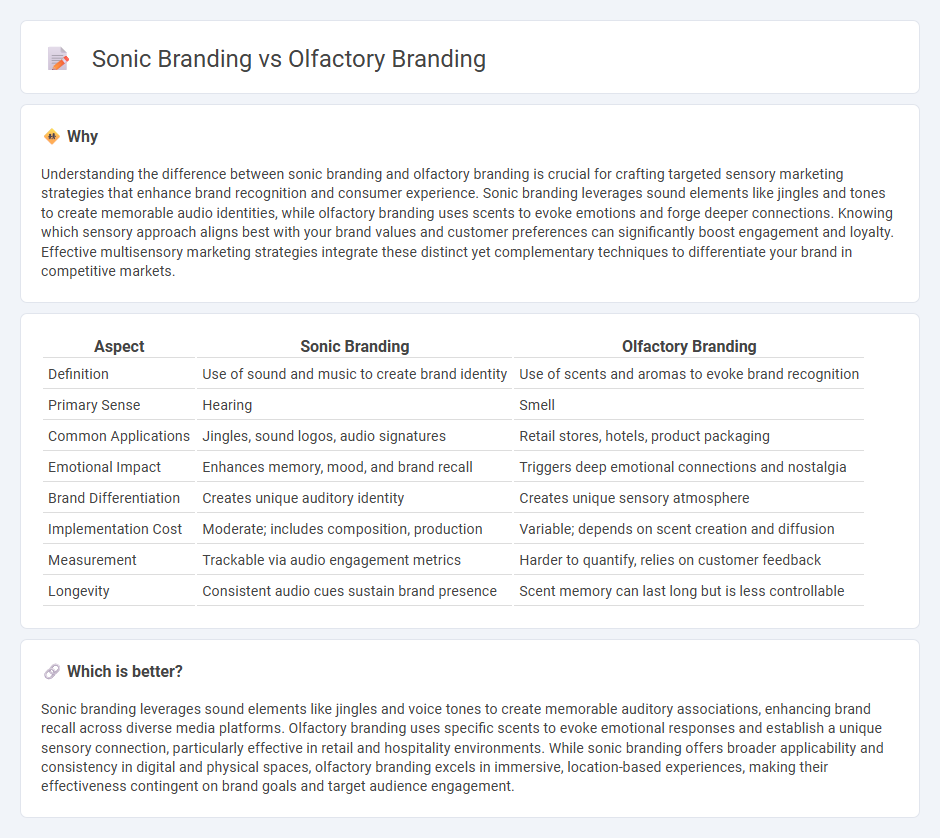
Sonic branding leverages sound elements like jingles, tones, and music to create memorable brand identities that enhance consumer recognition and emotional connection. Olfactory branding uses scents strategically to evoke specific feelings and memories, strengthening brand recall and customer loyalty through the sense of smell. Discover how these two sensory marketing techniques can uniquely elevate your brand's presence and impact.
Why it is important
Understanding the difference between sonic branding and olfactory branding is crucial for crafting targeted sensory marketing strategies that enhance brand recognition and consumer experience. Sonic branding leverages sound elements like jingles and tones to create memorable audio identities, while olfactory branding uses scents to evoke emotions and forge deeper connections. Knowing which sensory approach aligns best with your brand values and customer preferences can significantly boost engagement and loyalty. Effective multisensory marketing strategies integrate these distinct yet complementary techniques to differentiate your brand in competitive markets.
Comparison Table
| Aspect | Sonic Branding | Olfactory Branding |
|---|---|---|
| Definition | Use of sound and music to create brand identity | Use of scents and aromas to evoke brand recognition |
| Primary Sense | Hearing | Smell |
| Common Applications | Jingles, sound logos, audio signatures | Retail stores, hotels, product packaging |
| Emotional Impact | Enhances memory, mood, and brand recall | Triggers deep emotional connections and nostalgia |
| Brand Differentiation | Creates unique auditory identity | Creates unique sensory atmosphere |
| Implementation Cost | Moderate; includes composition, production | Variable; depends on scent creation and diffusion |
| Measurement | Trackable via audio engagement metrics | Harder to quantify, relies on customer feedback |
| Longevity | Consistent audio cues sustain brand presence | Scent memory can last long but is less controllable |
Which is better?
Sonic branding leverages sound elements like jingles and voice tones to create memorable auditory associations, enhancing brand recall across diverse media platforms. Olfactory branding uses specific scents to evoke emotional responses and establish a unique sensory connection, particularly effective in retail and hospitality environments. While sonic branding offers broader applicability and consistency in digital and physical spaces, olfactory branding excels in immersive, location-based experiences, making their effectiveness contingent on brand goals and target audience engagement.
Connection
Sonic branding and olfactory branding both leverage sensory cues to create strong emotional connections and enhance brand recognition. These multisensory strategies engage the auditory and olfactory senses, which are closely linked to memory and emotion centers in the brain, promoting deeper consumer recall and loyalty. Integrating sound and scent in marketing campaigns amplifies brand identity and differentiates products in competitive markets.
Key Terms
**Olfactory Branding:**
Olfactory branding leverages strategically designed scents to create lasting emotional connections and enhance brand recall, setting it apart from sonic branding, which uses sound and music. By activating the olfactory senses, this approach influences consumer behavior subtly yet powerfully, often driving increased customer loyalty and unique brand identity through scent associations. Discover how olfactory branding can transform your marketing strategy and deepen consumer engagement.
Scent Signature
Olfactory branding uses distinct scents as sensory logos to evoke emotions and strengthen brand identity, while sonic branding relies on sounds or jingles to create auditory recognition. A Scent Signature is a unique fragrance that embodies a brand's values and enhances customer experience through memory association and emotional response. Discover how incorporating a Scent Signature can elevate your brand's sensory strategy and create lasting impressions.
Ambient Fragrance
Ambient fragrance in olfactory branding creates immersive environments that enhance customer experience and reinforce brand identity through scent. Sonic branding uses sound elements to evoke emotions, but ambient fragrance appeals directly to the limbic system, triggering subconscious associations and stronger memory retention. Explore how integrating ambient fragrance can elevate your brand's sensory marketing strategy.
Source and External Links
Inside the World of Olfactory Branding, Where Companies Make ... - Olfactory branding involves deeply understanding the emotions consumers feel with a brand to create a signature scent that enhances brand awareness and emotional connection beyond just selling perfume or scent products.
The Olfactory Identity - Enigma - Olfactory identity is a sensory marketing technique appealing to the sense of smell that complements traditional branding by improving user experience and memorization, much like a logo does visually.
Scent Marketing in Action: 5 Business Sectors That Succeed - Also called scent branding, olfactory branding enhances customer experience by using specific scents aligned with brand identity, encouraging longer engagement and higher sales through emotional and memory triggers in the brain.
 dowidth.com
dowidth.com